| (insert your NIE or newspaper logo here) |
Weekly Online LessonOnline Lesson ArchiveGrade Level: 6-12
|
The Twisted Side of Spring
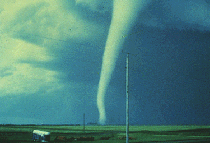 Spring's showers certainly help things grow, but they can also destroy and kill. That was the reminder this week, as tornadoes blew through the nation's midsection -- from Colorado to South Carolina, Wisconsin to Alabama.
Spring's showers certainly help things grow, but they can also destroy and kill. That was the reminder this week, as tornadoes blew through the nation's midsection -- from Colorado to South Carolina, Wisconsin to Alabama.
So far this year, more than 473 tornadoes have been spotted. About 300 of those occurred just over the last week, May 5-10, 2003, causing millions of dollars in property damage, killing over 40 people and injuring dozens more.
Although there's only so much humans can do when facing this powerful force of nature, scientists have learned a lot over the years about predicting when and where they'll happen. Plus, residents in regions of high tornado activity have learned how to protect themselves -- at least, as well as they can -- from a tornado's devastating blows.
 In this week's lesson, you'll discover how weather conditions can give rise to tornadoes. You'll also learn about the different types of tornadoes, and how you can track severe weather conditions in your own neighborhood and be prepared for the worst.
In this week's lesson, you'll discover how weather conditions can give rise to tornadoes. You'll also learn about the different types of tornadoes, and how you can track severe weather conditions in your own neighborhood and be prepared for the worst.
The Science Behind the Headlines
 Begin your lesson by getting an interactive overview of tornadoes at Discovery Channel's site, Extreme Weather: Tornado. Start at Grow Your Own Tornado and read about the Fujita Tornado Scale. Then hit the forward arrow to check out the different severity levels, from F1 to F5. How do the wind speeds and ground effects vary between them?
Begin your lesson by getting an interactive overview of tornadoes at Discovery Channel's site, Extreme Weather: Tornado. Start at Grow Your Own Tornado and read about the Fujita Tornado Scale. Then hit the forward arrow to check out the different severity levels, from F1 to F5. How do the wind speeds and ground effects vary between them?
Move on to the Anatomy of a Killer and the Birth and Death of a Tornado slideshow. How long was the lifespan of the featured tornado? Can you identify any of the anatomical parts of the tornado in the slideshow? Before leaving the Discovery Channel, take the Quiz to see if you'd be ready if a tornado hit your own neighborhood.
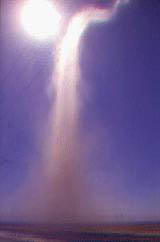 Now you'll be heading off to WW2010 (the weather world 2010 project) at the University of Illinois, where they've got a cool online meteorology guide on Severe Storms. As you browse through this guide, you can click any underlined word for its definition. Just click your browser's BACK button to return to where you left off.
Now you'll be heading off to WW2010 (the weather world 2010 project) at the University of Illinois, where they've got a cool online meteorology guide on Severe Storms. As you browse through this guide, you can click any underlined word for its definition. Just click your browser's BACK button to return to where you left off.
Tornadoes are just one type of severe storm, so begin your study with Flash Floods and Hail in the Dangers of Thunderstorms section. Using the NEXT arrows at the bottom, browse the other pages and read about Outflow, Downbursts and Tornadoes.
How do "straight-line" winds originate? What's a gust front? What's the difference between a microburst and a macroburst? How often do weak, strong and violent tornadoes occur? How do well-built homes compare for surviving weak vs. strong hits?
As you discovered in the Dangers section, tornadoes are rooted in thunderstorm activity. The next section delves deeper into the nature of severe storms, beginning with Types of Thunderstorms. Here, you'll learn about the thunderstorm spectrum, from single cell storms to supercells. Which ones are categorized as "severe"? What's the difference between a multicell cluster and a multicell line? Can you describe some of the characteristic features of each type of storm?
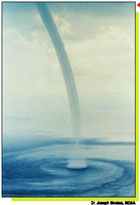 Let's break down these storms into even smaller pieces by looking at the Components of Thunderstorms. As you move through these sections -- Updrafts/Downdrafts, Wind Shear, Outflow Phenomena and Wall Clouds -- you'll read about how scientists watch and record each component's characteristics. How does understanding the behavior of each component help scientists predict if a tornado might develop?
Let's break down these storms into even smaller pieces by looking at the Components of Thunderstorms. As you move through these sections -- Updrafts/Downdrafts, Wind Shear, Outflow Phenomena and Wall Clouds -- you'll read about how scientists watch and record each component's characteristics. How does understanding the behavior of each component help scientists predict if a tornado might develop?
Now you get to spend time in the eye of the storm -- that is, in the Tornadoes section. Here, the Useful Diagrams, Low-level Flow, Evolution and Cyclic Storms pages help illustrate how the weather conditions and storm components come together in the "big picture." If you have time, browse the Modeling section in the guide, which shows how using computer-modeling helps experts understand supercell behavior.
So how do weather experts use these different types of data and collected observations to piece a storm puzzle together and make tornado predictions? What are the limits of their methods and tools? Do any storm components seem to have stronger influences on tornado formation than others?
Preparing for the Storm
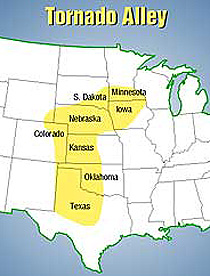 Now that you understand how severe storms work, it's time to explore how their nature affects you and your neighbors, and how you can prepare for the possibility of a storm's tornadoes, hail, wind or rain that could cause severe personal injury or property damage.
Now that you understand how severe storms work, it's time to explore how their nature affects you and your neighbors, and how you can prepare for the possibility of a storm's tornadoes, hail, wind or rain that could cause severe personal injury or property damage.
The National Oceanic and Atmospheric Administration has a great Tornadoes site for severe weather updates, statistics and safety suggestions. Go to the Nature's Most Violent Storms page, and scroll through the overview on tornadoes to the Frequency of Tornadoes section. Check out the Months of Peak Tornado Occurence for your state. Note that a few states have peaks in both the spring and fall. Also see the graphs titled United States Totals, 1961-1993 and U.S. Reported Tornadoes and Average Deaths Per Year.
Keep scrolling down the page, reading Stay Informed About the Storm, What to Listen For..., Environmental Cues and Tornado Safety, making sure you know how to help create or participate in a Family Disaster Plan and at School. What do you know about tornadoes that can help you make the best decisions for keeping safe if faced with that threat?
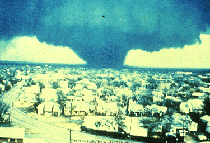 While you're waiting for the next storm to hit, you can check out the Storm Reports and browse around the Storm Prediction Center.
While you're waiting for the next storm to hit, you can check out the Storm Reports and browse around the Storm Prediction Center.
From here you can look at Today's Storm Report, Yesterday's Storm Report or look at the Storm report data for past days by typing in a specific date. Each report shows occurrences of tornadoes, wind damage and large hail, along with individual listings of each event, including its location, who reported it and if there was any property damage or personal injury.
Also browse through the Statistical data for this year, checking out the Monthly Tornado Statistics or Deadly Tornadoes in 2003, or browse through the Stastical data for previous years. Do tornado deaths ever occur in some of the same regions year after year? If so or if not, why do you think that's the case?
Can you find any tornado deaths that have occurred in your state or in a neighboring state since 1997? If the closest state where tornadoes have killed people is two or more states away, can you explain why these events are so rare in your part of the country?
Newspaper Activities
As you look through an issue of Targetnewspaper, do you see any stories about storm activity, either in your local area or somewhere else in the country or in the world? Is the storm severe? Had the severity of the storm been accurately predicted by experts? What were some of the effects of the storm? How did the residents react? Is the storm activity over or might it be part of a series of severe weather events in the region? Over how much land area (like, over one town or state or through several) does the storm cover? What period of time -- minutes or hours -- did the area get hit by severe conditions? If a tornado was sighted, did it cause any damage?
© Copyright 2002
Learners Online, Inc.
